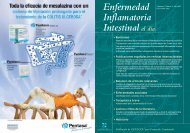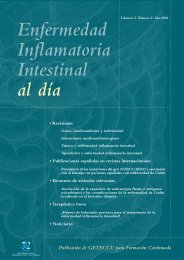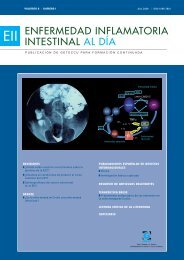LECTURA CRÍTICA DE LA LITERATURAJ.F. Muñoz Núñez 1 , J. P. Gisbert 21Sección de Aparato Digestivo. Complejo Asistenci<strong>al</strong> de León. León. España.2Servicio de Aparato Digestivo. Hospit<strong>al</strong> Universitario de la Princesa. Madrid. España.Early combined immunosuppression or convencion<strong>al</strong>management in patients with newly diagnosed Crohn’s disease:an open randomised tri<strong>al</strong>Tratamiento inmunosupresor combinado precoz frente a tratamiento convencion<strong>al</strong> enpacientes con enfermedad de Crohn de nuevo diagnóstico: ensayo abierto <strong>al</strong>eatorizadoD'Haens G, Baert F, van Assche G, Caenepeel P, Vergauwe P, Tuynman H, De Vos M,van Deventer S, Stitt L, Donner A, Vermeire S, Van de Mierop FJ, Coche JC, van derWoude J, Ochsenkühn T, van Bodegraven AA, Van Hootegem PP, Lambrecht GL,Mana F, Rutgeerts P, Feagan BG, Hommes D, Belgian Inflammatory Bowel DiseaseResearch Group, North-Holland Gut Club.Imelda Gastrointestin<strong>al</strong> Clinic<strong>al</strong> Research Centre, Bonheiden, Belgium.ResumenSe trata de un estudio multicéntrico, abierto, prospectivo y <strong>al</strong>eatorizado que compara dos estrategias de tratamiento diferentes:inmunosupresión precoz o tratamiento convencion<strong>al</strong> en pacientes con enfermedad de Crohn activa de corta evolución (menorde 4 años) y sin tratamiento previo con corticoides, inmunomoduladores o biológicos. La pauta de inmunosupresión precozconsistía en la administración de 3 dosis de infliximab a las 0,2 y 6 semanas en combinación con azatioprina a las dosis habitu<strong>al</strong>es,readministrando infliximab en caso de actividad o bien corticoides en caso de no respuesta <strong>al</strong> biológico.El grupo asignado <strong>al</strong> tratamiento convencion<strong>al</strong> recibía un ciclo de corticoides como inducción, seguido de azatioprina e infliximabde forma secuenci<strong>al</strong> en caso de no conseguirse el control de la enfermedad.La variable princip<strong>al</strong> del estudio era la remisión sin corticoides y sin cirugía, ev<strong>al</strong>uada en las semanas 26 y 52. En ambos interv<strong>al</strong>osla estrategia de inmunosupresión precoz consigue diferencias significativas con respecto <strong>al</strong> tratamiento convencion<strong>al</strong>: 60%frente a 35,9% en la semana 26 y 61,5% frente a un 42,2% en la semana 52 respectivamente. A partir de este punto no hubodiferencias entre los dos grupos de tratamiento. El porcentaje de pacientes que desarrolló efectos secundarios fue similar en ambosgrupos. Con estos resultados la conclusión de los autores es que el tratamiento intensivo precoz en la enfermedad de cortaevolución consigue unos mejores resultados que el abordaje convencion<strong>al</strong>, reduciéndose el empleo de corticoides.SummaryThis study is a multicentric, open-label, prospective and randomized tri<strong>al</strong> that compares two different strategies: early combinedimmunosuppression versus convention<strong>al</strong> treatment in patients with active Crohn´s disease who had been recently diagnosedand had not previously received glucocorticoids, antimetabolites, or infliximab. Patients assigned to early combined immunosuppressionreceived three infusions of infliximab in doses of 5 mg/kg bodyweight at weeks 0, 2, and 6, in combinationwith azathioprine. In patients whose symptoms worsened were given addition<strong>al</strong> infusions of infliximab and, if symptoms persistedthen, they initiated methyl-prednisolone. Patients in the convention<strong>al</strong> management group received induction treatmentwith either methyl-prednisolone or budesonide followed, in sequence, by azathioprine and infliximab. The primary outcomemeasures were remission without corticosteroids and without bowel resection at weeks 26 and 52. At the two points the earlycombined immunosuppression group has statistic<strong>al</strong>ly significant better results than convention<strong>al</strong> management group: 60% versus35.9% after 26 weeks and 61.5% versus 42.2% after 52 weeks, respectively. After week 52, the proportion of patients inremission did not differ between the two groups. Adverse events were similar in both groups. With these results, authors concludethat initiation of more intensive treatment early in the course of the disease could result in better outcomes than convention<strong>al</strong>management for induction of remission and reduction of corticosteroid use.P<strong>al</strong>abras clave: enfermedad de Crohn, inmunosupresión precoz, top-down, step-up.Keywords: Crohn´s disease, early immunosuppression, top-down, step-up198 • Enfermedad Inflamatoria Intestin<strong>al</strong> <strong>al</strong> día - Vol. 7 - Nº. 2 - 2008
Lectura crítica de la literaturaComentarioLa introducción precoz de los tratamientos inmunomoduladoreso biológicos en el curso de la enfermedad deCrohn es una estrategia atractiva conceptu<strong>al</strong>mente porvarias razones. En primer lugar, es una enfermedad quetiene una marcada tendencia a la aparición de complicacionesen su evolución (1) y si consideramos que uno delos objetivos primordi<strong>al</strong>es del tratamiento es evitarlas, habríaque introducir aquellos fármacos con capacidad paramodificar la historia natur<strong>al</strong> de la enfermedad en fasesprecoces, cuando todavía no se han presentado. Desdeeste punto de vista, el estudio de D´Haens y cols. es el primeroque compara la introducción precoz de inmunomoduladoresfrente <strong>al</strong> tratamiento convencion<strong>al</strong> en adultospero, lamentablemente, ni el número de pacientesincluidos ni la duración del seguimiento re<strong>al</strong>izado permitev<strong>al</strong>orar si esta nueva estrategia es capaz de prevenirla aparición de complicaciones.Por otro lado, la introducción precoz de los inmunomoduladorespodría permitir un control más temprano de laenfermedad evitando el empleo prolongado o frecuentede fármacos con importantes efectos secundarios comolos corticoides, hecho de especi<strong>al</strong> relevancia en niños, dondesí se ha re<strong>al</strong>izado un ensayo clínico con resultados favorables(2) aunque no necesariamente extrapolables a lapoblación adulta. Conocemos además, que la induccióncon biológicos puede mejorar los resultados de los inmunomoduladoresa medio plazo, <strong>al</strong> menos en la enfermedadde Crohn corticodependiente (3) , por lo que parece razonableutilizar esta forma de control de la enfermedadantes del desarrollo de corticodependencia. Lamentablemente,en el momento del diseño del presente trabajoaún no estaban disponibles los resultados del estudio AC-CENT I (4) por lo que se adoptó una estrategia de inducciónseguida de tratamiento a demanda, no conociendo quéinfluencia podría haber tenido el tratamiento de mantenimiento.Por último, la utilización de la terapia biológicaen las fases inici<strong>al</strong>es de la enfermedad podría conseguirmejores resultados inici<strong>al</strong>es que en pacientes con enfermedadevolucionada, hecho que se sugiere por varios análisis“post hoc” de ensayos clínicos con diferentes biológicos(5, 6) incluso con diferentes mecanismos de acción (7) . Porlo tanto, su empleo precoz contribuiría a una mejor optimizaciónde los resultados de estos fármacos.En contraposición, este tratamiento intensivo conllevaque un porcentaje apreciable de enfermos reciba un tratamiento,no exento de efectos secundarios, que no hubierasido necesario por la buena evolución de la enfermedad<strong>al</strong> menos a medio plazo. Ante la f<strong>al</strong>ta de factorespredictivos de m<strong>al</strong>a evolución con suficiente capacidadpronóstica, el presente estudio de D´Haens y cols. nos proporcionamás información sobre la eficacia y seguridadde estas dos posibles estrategias: tratamiento intensivoprecoz frente <strong>al</strong> convencion<strong>al</strong>. Aplicaremos, como vienesiendo habitu<strong>al</strong> en esta sección, la metodología propuestapor el grupo CASP (Critic<strong>al</strong> Apprais<strong>al</strong> Skills Programme oprograma de habilidades en lectura crítica) en la ev<strong>al</strong>uaciónde esta publicación.¿Se orienta el ensayo clínico a una pregunta claramentedefinida?Sí. La población de estudio está bien definida e incluye apacientes con diagnóstico en los últimos 4 años de enfermedadde Crohn, con actividad que establece en un CDAIsuperior a 200 y sin tratamiento previo con corticoides, inmunomoduladoreso biológicos. La intervención ev<strong>al</strong>uadaestá claramente definida así como el comparador o tratamientoconvencion<strong>al</strong>, aunque éste último requiere <strong>al</strong>gunaconsideración. En primer lugar, la dosis elegida de corticoidesequiv<strong>al</strong>ente a 40 mg de prednisona no parece lamás adecuada. De hecho, aunque en el estudio cooperativoamericano se utilicen dosis similares los resultados delestudio europeo con 48 mg/día de metilprednisolona o losde la serie de Modigliani (8) con 1 mg/kg de prednisona sonsuperiores. En el presente trabajo la dosis media administradaera de 0,64 mg/kg, claramente inferior, lo que puedecomprometer los resultados inici<strong>al</strong>es del grupo asignado<strong>al</strong> tratamiento convencion<strong>al</strong>. Curiosamente en caso deno respuesta a las 4 semanas a la dosis citada de corticoidesse administraba el doble de la dosis inici<strong>al</strong>. Entonces,si se asume que dosis más elevadas pueden ser más eficaces¿por qué no se escogió esta dosis como la inici<strong>al</strong>?Por otro lado, la princip<strong>al</strong> variable de eficacia fue la remisiónsin corticoides y sin resección intestin<strong>al</strong> en las semanas26 y 52. Aparentemente es un objetivo sólido, sobretodo si tenemos en cuenta que la pauta de descensode esteroides está predefinida en el grupo de tratamientoconvencion<strong>al</strong>, sin embargo, esto no es así para el grupode inmunosupresión precoz. Fin<strong>al</strong>mente, los criterios derespuesta empleados son arbitrarios y aunque estrictospara puntuaciones <strong>al</strong>tas del CDAI, no lo son tanto parapuntuaciones inferiores a 250 puntos.¿Fue <strong>al</strong>eatoria la asignación de los pacientes <strong>al</strong>os tratamientos?Sí. Los pacientes fueron <strong>al</strong>eatorizados en bloques de 4 segúnuna secuencia generada por ordenador. Sin embargo,la asignación no fue encubierta ni para los investigadoresni para los pacientes.¿Fueron adecuadamente considerados hasta elfin<strong>al</strong> del estudio todos los pacientes queentraron en él?Sí. Se an<strong>al</strong>izan det<strong>al</strong>ladamente todos los pacientes quefueron ev<strong>al</strong>uados <strong>al</strong> comienzo del estudio, así como lascausas de su exclusión <strong>al</strong> inicio del mismo o de la retiradaprematura (figura 1 de la publicación origin<strong>al</strong>). Laspérdidas fueron importantes, concretamente del 21%(14/67) en el grupo asignado a inmunosupresión combinaday del 26% (17/66) en el que recibió tratamiento convencion<strong>al</strong>.Un hecho destacable es que el análisis no fuepor intención de tratamiento sino por protocolo.¿Se mantuvieron ciegos <strong>al</strong> tratamiento lospacientes, los clínicos y el person<strong>al</strong> del estudio?No. El estudio fue abierto de forma que tanto los investigadorescomo los pacientes conocían el tratamiento a re-199 • Enfermedad Inflamatoria Intestin<strong>al</strong> <strong>al</strong> día - Vol. 7 - Nº. 2 - 2008











